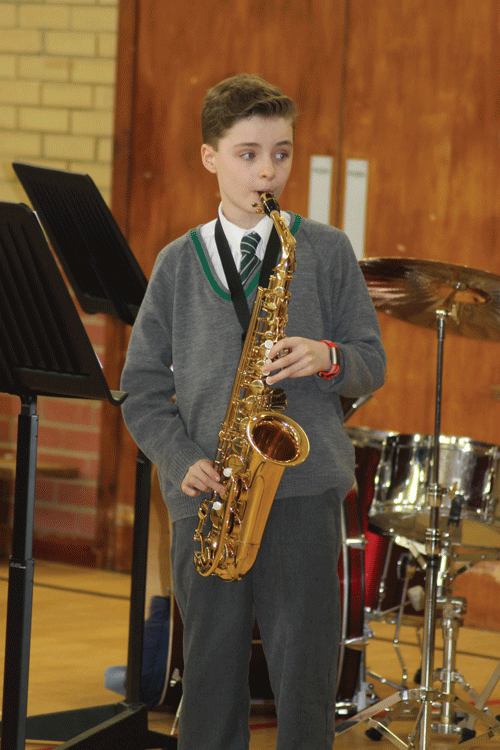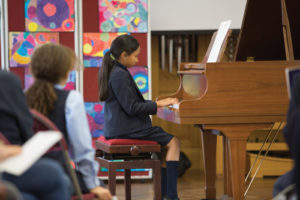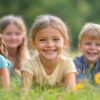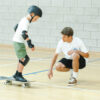
by Mr Adrian Perks, Headmaster
St. Andrew’s School, Woking
In a world which seems increasingly to be driven by social media with its limiting and somewhat populist and opinionated messages, I have been concerned for some time that our children are increasingly isolated from a reality which still requires a broad and holistic view of the world to provide balance and clarity. There remains therefore, in our opinion, a significant need for our young children to be exposed to educational experiences which allow them to explore and investigate areas of learning. This will provide them with the tools to make better informed judgements in the course of their young lives.
 This journey of broad discovery essentially starts at primary and indeed pre-primary level and provides all children with the opportunity to seek out and explore areas of interest and to develop talent which provide many with a lifelong love of learning. Over the years I have spoken to many parents whose main requirement, when considering the options for their children, is to ensure their children are happy. Happiness and thus mental health are of key importance in a world of increased pressure and expectations. Children supported and nurtured and indeed loved within their school will automatically have a head start and hopefully will develop a hunger for knowledge. Of course the breadth of study and the balance of the curriculum is also key and provides the option for all to explore their individual burgeoning interests. All children develop academically at a different pace. On many occasions I have had to reassure anxious parents that their child is not a failure because they are struggling with their spellings or their fractions. These are just moments in time in the life of a young person and should not be the basis of perceived success nor failure.
This journey of broad discovery essentially starts at primary and indeed pre-primary level and provides all children with the opportunity to seek out and explore areas of interest and to develop talent which provide many with a lifelong love of learning. Over the years I have spoken to many parents whose main requirement, when considering the options for their children, is to ensure their children are happy. Happiness and thus mental health are of key importance in a world of increased pressure and expectations. Children supported and nurtured and indeed loved within their school will automatically have a head start and hopefully will develop a hunger for knowledge. Of course the breadth of study and the balance of the curriculum is also key and provides the option for all to explore their individual burgeoning interests. All children develop academically at a different pace. On many occasions I have had to reassure anxious parents that their child is not a failure because they are struggling with their spellings or their fractions. These are just moments in time in the life of a young person and should not be the basis of perceived success nor failure.
 Confidence is key together with a large dose of resilience. So your child isn’t going to win a Spelling Bee! But watch them play their musical instrument with pride and courage or hear them sing in front of an admiring audience. Look at their artwork and wonder at their developing sensitivity. Stand back in awe at their prowess on the hockey field and feel proud at their selfless teamwork and support for others. Marvel at their enthusiasm for their castle project in history or their ability to recite verse in French or Spanish. And admire them on the stage in the school production as a child you barely recognise as the one who you take home every day from school!
Confidence is key together with a large dose of resilience. So your child isn’t going to win a Spelling Bee! But watch them play their musical instrument with pride and courage or hear them sing in front of an admiring audience. Look at their artwork and wonder at their developing sensitivity. Stand back in awe at their prowess on the hockey field and feel proud at their selfless teamwork and support for others. Marvel at their enthusiasm for their castle project in history or their ability to recite verse in French or Spanish. And admire them on the stage in the school production as a child you barely recognise as the one who you take home every day from school!
The impact of a broad and balanced curriculum is felt in so many areas and over the years as a Headmaster I have noticed a massive positive change in our children as a result of our focus on providing a broad curriculum. It is simple – not every child will be a star in maths or English but opportunity and encouragement in other equally important areas inevitably lights a flame. A flame which hopefully will burn brightly as the years pass by. The important aspect being the interest nurtured by allowing children to shine in areas other than the core boosts confidence. This is the key to learning and results in commendable achievement across the academic spectrum. Many schools have redoubled their efforts in these areas and have reaped the rewards for their pupils. Over the years our children have achieved significant recognition through scholarship or otherwise in many areas. Indeed this year we were fortunate enough to receive a record number of scholarships in art, drama, music and sport together with academic awards. I strongly believe that in a non-selective environment children are the beneficiaries of a structure which sets high expectations but more importantly provides a broad base for knowledge and ultimately confidence. A healthy antidote perhaps, to a judgmental world.
St. Andrew’s School is a respected and thriving co-educational Nursery, Pre-Prep and Prep school for girls and boys aged 3-13. St. Andrew’s seeks to create a nurturing and happy environment of trust and support in which all pupils are encouraged and enabled to develop their skills, talents, interests and potential to the full.
Next open mornings:
Saturday 3rd November 2018
and Friday 15th March 2019.
www.st-andrews.woking.sch.uk
by Fiona Edwards
Little Dippers
Baby swimming has become increasingly popular over the last 10 years and with good reason. As one of the first activities you can do with your new baby it not only gives you special one on one time with your baby, but also imparts your baby with a skill for life.
But taking that first step into the pool with your baby definitely comes with its fair share of questions and nerves. What if they get cold? What if they cry? What about their ears? Rest assured your babies are so much more adaptable than you realise and swimming is a completely natural progression for them having spent nine months in the fluid environment of the womb.
What’s more, babies are born with a natural dive reflex action which means they are already fully equipped to go underwater. It is truly amazing to see your baby dive underwater for the first time and come up again completely unfazed!
 Safety
Safety
One of the first considerations for going baby swimming must be safety. With drowning still the third most common cause of accidental death in children, learning to swim must surely be a priority for all parents. Teaching your baby key water safety techniques and confidence in the water will give them skills that, if they should ever fall into a pool, lake, pond or even the bath, will mean that they won’t panic and can utilise the skills that they have learnt – which could potentially save their life.
Bonding
Baby swimming is a great way to spend special one on one time with your little one away from the intrusions of everyday life. This is a time when you can truly focus on just you and your baby. Plus the added benefits of skin on skin contact can help to regulate baby’s heart rate and breathing as well as making them feel secure. For mums, it can release hormones to help with breastfeeding and build the nurturing instincts. It’s also a great way for dads to get involved and enjoy special bonding time.
Physical and physiological benefits
The buoyancy of the water enables babies to use muscles they could never use on land and they love the sense of freedom to kick freely. Despite looking gentle, swimming is great exercise for your baby, helping to strengthen their heart, lungs and respiratory capacity which in turn aids the development of the brain.
In fact, the exercises taught in baby swim classes, kicking, reaching, learning and responding to commands, provide the perfect stimulation for your baby’s brain and helps to develop their cognitive skills and hand/eye co-ordination. It has also been proven that the combination of activities in the pool strengthens nerve pathways between the two sides of the brain, helping to store and retrieve information more effectively. All good for future learning!
What’s more, regular swimming can improve your child’s eating and sleeping patterns – surely a bonus for everyone!
Fun for all the family Swimming is great exercise for all the family and is something you can enjoy together even when babies are very little.
Parents’ confidence
Don’t worry if you are not confident in the water yourself, most baby swim classes take place in shallow pools and don’t require you to do much more than hold your baby. However nervous you may be feeling make sure you try to remain calm and keep a big smile on your face as your baby will pick up any apprehension that you may feel. It’s amazing watching parents’ confidence grow as they watch their babies thrive in the water.
 Meet new friends
Meet new friends
Besides learning key survival skills swimming is fun! Singing songs, splashing around, blowing bubbles and playing games, it’s an easy way for parents to get involved and meet new friends along the way. It’s best to go somewhere with small groups so that everyone can get to know each other and your baby will respond to other babies in the group and enjoy the clapping and splashing.
A few things to think about before you go swimming
You can start swimming with your baby from birth although most parents tend to wait until their baby is around six to eight weeks. Contrary to popular belief, babies do not need to have had their immunisations before coming to a pool.
It is best to book a course of baby swimming classes before you take your baby to the pool on your own, so that you can learn how to hold your baby
and exercises that you can practise with them. Smaller classes with groups of around six or seven in private pools provide a calmer quieter environment for you and your baby. Try to find warm water pools; babies can’t regulate their temperature so look for classes that take place in pools ideally heated to around 32 -34O C.
Before choosing a class think about your baby’s feed and nap times. A tired or hungry baby won’t enjoy their class and give yourself plenty of time to get to your class and get changed. It’s amazing how much longer everything takes with a baby in tow and you don’t want to start your class flustered and stressed.
You can help prepare your baby for lessons by having fun in the bath splashing, grasping toys and singing songs.
With all these benefits surely it’s worth taking the plunge!
Little Dippers have been teaching babies to love the water for 25 years.
Classes in lovely warm water pools in the North Laine and Patcham in Brighton with free drop in sessions.
Free trial available to book.
For more details check our website www.littledippers.co.uk or call 01273 229 390
The football World Cup may be over, but another great sporting events kicks off in less than two weeks. National Fishing Month (NFM) 2018 – the highlight of the fishing year – begins on 27th July and gives everyone the chance to give angling a go under the guidance of specially-trained experts. And everything is free!
NFM is now in its 26th year of unrivalled success, during which it has helped to introduce hundreds of thousands of people to a lifelong sport and the huge happiness it brings. Millions of anglers have discovered
already that angling takes them to beautiful places to catch wonderful fish, making lots of new friends on the way. It’s both exciting and relaxing, generating huge personal satisfaction though close and informed contact with nature. Most of all, it’s great fun.
This year there are more than 250 events nationwide, listed online at www.nationalfishingmonth.com so there’ll be a participating venue close to everyone. Taking part is simplicity itself – just need to register online and then turn up. Everything will be provided without charge, and most people will experience the ultimate thrill of catching their first fish under the watchful guidance of their coach.
 Everyone who takes part will go home with presents… a NFM ‘goody bag’ containing the ‘Get Into Fishing’ booklet full of information on how to get started and advice on different types of fishing, a log book to make a note of their first catches and a special certificate as a memento of their days free fishing.
Everyone who takes part will go home with presents… a NFM ‘goody bag’ containing the ‘Get Into Fishing’ booklet full of information on how to get started and advice on different types of fishing, a log book to make a note of their first catches and a special certificate as a memento of their days free fishing.
Naidre Werner, Chairman of the Angling Trades Association which organises NFM, commented: ‘July and August really will be focused on angling. There are hundreds of events going on nationwide, beginning with a launch event at The Game Fair at Ragley Hall, near Evesham, Worcestershire (on 27th, 28th and 29th July). National Fishing Month will have its own fly and coarse teaching areas’.
Across the country, leading tackle company supporters such as Daiwa, Dinsmores, Fladen, Middy, Leeda, Pure Fishing and Angling Direct have all donated products and time in support of NFM so that tackle can be used on the bank for coaching and as prizes at events.
Details of events that are scheduled already are listed on the National Fishing Month website at www.nationalfishingmonth.com and can be viewed by entering your postcode. The nearest events and their details will then be shown and you will be able to book a coaching time to suit you.
NATIONAL FISHING MONTH 2018 RUNS BETWEEN 27TH JULY AND 2ND SEPTEMBER.
by Charlie Nash
YogaFrogs
We potentially think of yoga as something for adults, yet yoga has so much to offer everyone beyond the adult learners. It’s no wonder then that a growing number of children and families are opting to participate in yoga classes tailored for children. With many yoga teachers now offering yoga for both children and their families, there’s plenty of opportunity around Sussex to experience this, whether it might be in your local community hall, yoga studio, festival, after-school club or a 1:1 session in the comfort of your own home.
Yoga was developed up to 5,000 years ago in India as a comprehensive system for well-being on all levels; physical, mental, emotional and spiritual. In the West we often focus on the physical aspect of yoga. The other elements, which go hand-in-hand with the physical, are starting to be recognised and shared with students both young and old alike.
These benefits are being recognised by educational authorities across the country with more primary and secondary schools acknowledging the benefits yoga has on their students’ mental and physical health, particularly around SATS and other public exams.
In an age where technology has taken over our lives, the benefits of yoga couldn’t be in greater need. Whether we like it or not, children and adults are bombarded with information overload from television, the Internet and smartphones. It’s said that in the course of a day, the average person in a western city is exposed to as much data as someone in the 15th century would encounter in their entire lifetime.
Yoga allows children to take time out from all of the above. With continued practice there’s a wealth of benefits that can enrich their entire lives all the way through to adulthood. Yoga is not only fun, it encourages children to think freely and let their imaginations go wild, as they explore the many asanas (postures) that link to nature and animals. Children thoroughly enjoy the connections with their bodies, with movement helping to promote self-awareness of their limbs, joints and muscles from a young age. Yoga subtly teaches us about the interconnectedness of our bodies. From toes and jaws, to heart and lungs. This allows us to keep every part of our body alive and supple, no matter how small.
With regular practice children can find deeper concentration, which may have positive effects in both school and family life. This is achieved through the opportunity and encouragement to clear the mind and to focus single-handedly on each asana at a time. Beyond the physical, yoga teaches children to quiet the mind through different relaxation and breathing techniques. This can help with anxiety and stress, being a skill the children can practise anytime and anywhere.
Children learn to be non-competitive and non-judgemental of themselves and others. They learn to share and take turns with other children in the class, promoting kindness and gratitude from a young age. They learn, through yoga, that they are OK just the way they are and don’t need to compare themselves to others. This allows them to become more accepting and understanding of not only themselves, but also everybody else around them.
The Dalai Lama said “If every eight year old in the world is taught meditation, we will eliminate violence from the world within one generation”. With a rapidly expanding and growing world, this quote could not be more relevant. Allowing children to be grounded and centred in their thoughts is one of the greatest gifts we can give. Making sure their true nature is made up of compassion, love, and wisdom, which can then be shared with the world.
YogaFrogs – bringing weekly yoga, mindfulness, meditation and creativity to children, teens and families across East and West Sussex,
www.yogafrogs.co.uk
How can you prepare a child for the demands of cycling on a road? Some parents will balk at letting their children near roads with traffic, let alone on them. It would be foolish to pretend there are no risks involved. However, at some point your child will use roads alone – if not on a bike, then as a pedestrian or behind the wheel of a car as a young adult. Those who are used to independence and who can make risk assessments will be safer, better road users than those who have been isolated from the outside world. It doesn’t require leaping in at the deep end. Exposure to traffic is something best done by degrees.
Co-riders and passengers
To begin with your child will travel on the road under your direct control, either as a passenger in a seat or trailer or as a co-rider on a tandem or trailer-cycle. As steering and braking are under your sole control, the only impact will be on how you cycle.
You will inevitably ride in a less swashbuckling style. Mostly it’s because you are always more careful when kids are around; it’s human nature. Partly it’s because a heavier bicycle takes longer to get up to speed and to slow down, so your riding benefits from being smoother and less stop-start. Try to anticipate junctions by arriving slowly and in the right gear for setting off. Allow the extra second or two you’ll need to pull away when judging gaps in traffic.
A child on a tandem or trailer-cycle or in a cargo bike may pick up some traffic skills from you whilst you are riding. You can reinforce this by asking an older child to see if there’s anything behind and to signal left or right when needed. (You will still have to do both these things yourself if it is safe enough.)
Tandems remain useful up to the age of 11 and possibly beyond. By that age, though, most children will want to ride solo. One reason is image. The desire to conform becomes very strong and children don’t want to be seen as ‘different’ by their friends. The tandem that was once so popular may now be seen as geeky.
Chaperoned cycling
Traffic awareness develops around the age of eight to 10 years old, which is usually when school-based cycle training tends to start. Up until that time, at least, you will need to supervise your child on roads. He or she might be a proficient cyclist and yet make misjudgements about traffic.
Before you set off
Before setting out together there are some things you need to be sure of. One is that your child can stop, start, steer and otherwise be competent at cycling – on a bike that’s roadworthy. Another is that your child will respond to your instructions, doing what you say, when you say it. Do explain the reasons for this in advance: that you’re not being bossy or cross, just careful. The final requirement is that your child knows the difference between left and right. When you say ‘go left’ it’s important your charge doesn’t cycle into the centre of the road instead.
On the road
When you’re riding, it’s best if your child leads and you cycle a bike length or half a bike length behind. That way you can watch your child at all times and call out instructions. Your child should ride towards the left side of the road, but at least 50cm out from gutter, while you ride further out, possibly taking the lane. This means traffic has to come around you and can’t cut in too close to your child, who might veer or wobble or simply be freaked out by cars passing too close.
If you need to do so, it is perfectly legal to cycle side-by-side with your child. (Many drivers are unaware that cyclists can ride two abreast, so be prepared for the odd pipped horn.) It’s worth moving forward to ride alongside as you come up to a side road. Two cyclists are more visible than one, and with both of you to pass, any side-road driver is less likely to engage in the brinkmanship of edging or accelerating out in front of you.
Give encouragement as you ride along and make your instructions calm and clear.
Information should flow both ways. In particular, your child should be taught to say ‘Stopping!’ rather than halting right in front of you without warning. Ideally, your child should also signal left before pulling in to the side. (No one uses the one-armed up-down flap that signifies slowing down nowadays, and it may only confuse drivers.)
Start on easier, less trafficked roads and work up. There will be situations in which it is easier or necessary to get off the bikes. Perhaps a hill is too steep. Perhaps a junction is too complex. In time your child will be able to ride these. For now, take it one step at a time. And remember: communication, communication, communication.
Independent cycling
Independent cycling means riding on the road. Children cycling on the pavement is illegal, but there is no criminal liability for children under the age of 10, and it is tacitly accepted by everyone that the pavement is where younger children will ride. By the age of 11, however, and perhaps two or three years earlier, (if you feel they are capable of it) most children can learn to ride safely on the road without supervision – not on all roads but certainly on roads that aren’t busy and don’t have complex junctions.
Cycle training has traditionally taken place in the later years of primary school. Not only are children ready for training then, they will soon need it. The average distance from home to secondary school is 3.3 miles in England – too far to walk perhaps, but not difficult by bike. Training has moved on quite a way since the cones-in-the-school-playground days of the Cycling Proficiency Scheme. The National Standard for Cycle Training (called Bikeability) takes place largely on the road in real-world, supervised conditions. And the training itself is no longer administered by schoolteachers but by qualified, accredited cycle instructors.
Local authorities sometimes provide free or subsidised training. Your nearest cycle training provider can fill you
in about charging policy.
Taken from www.cyclinguk.org
To see the full article visit www.cyclinguk.org/article/cycling-guide/cycling-road-children











